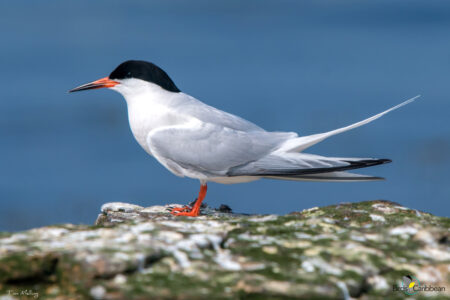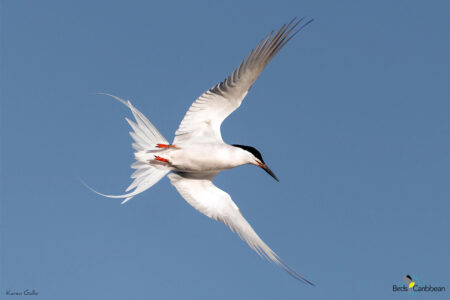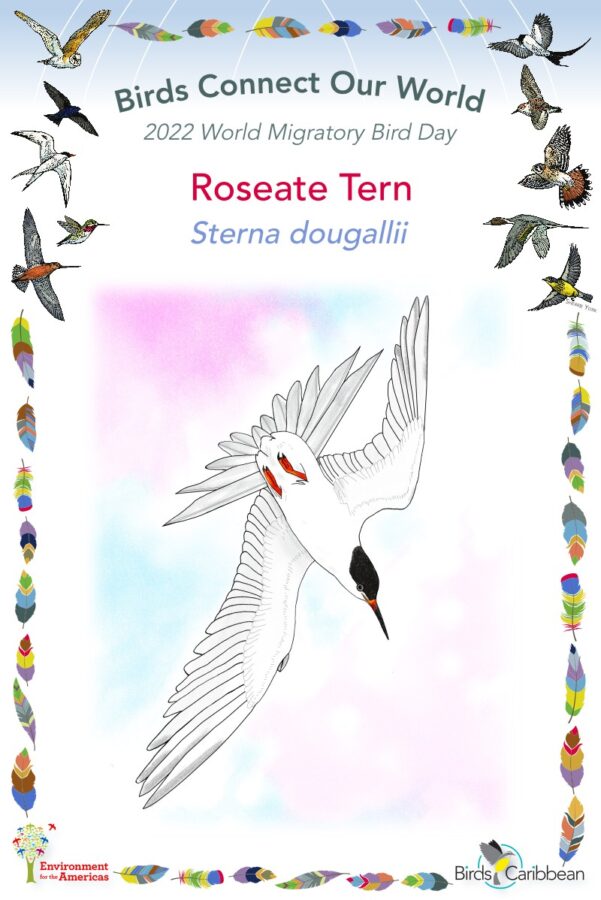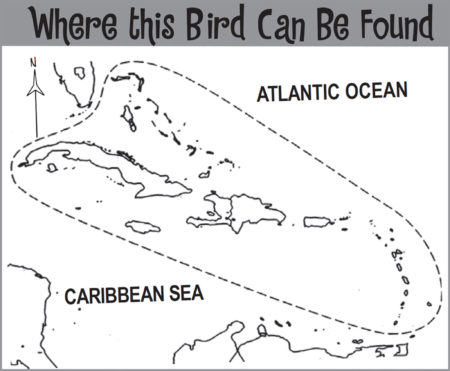Celebrate World Migratory Bird Day (WMBD) with us in 2022! This year’s theme is “Dim The Lights for Birds at Night”. Have fun learning about a new migratory bird every day. We have colouring pages, puzzles, activities, and more. Download for free and enjoy nature with your family at home.
Migratory Bird of the Day: Roseate Tern
Roseate Terns might be one of the Caribbean’s most elegant fliers, flitting about like bats as they swoop down to catch tiny silver baitfish. They are so good at finding schools of baitfish that in some parts of the Caribbean they are known as “Bonito birds” because fisherfolk know that if they cast lines under where Roseate Terns are diving, they are likely to catch bonitos and tuna that are also in the area to catch small bait fish prey!
In the spring when Roseate Terns arrive in the Caribbean to breed, they have solid black beaks and a light rosy blush across their white chests, which gives them their name. As spring progresses, Roseate Tern beaks start to turn dark orange and they lose their pink coloration. By the time they leave the Caribbean for their wintering grounds in South America in the fall, they look very different then when they arrived!
Roseate Terns have a restricted range in North America, meaning they only breed in certain areas. In continental North America, they primarily breed only in a few large colonies in Massachusetts, New York, and Maine. In the Caribbean, they are scattered across the region, with breeding colonies in Florida, Cuba, Puerto Rico, and the Virgin Islands, to name a few. Wherever they are found, breeding Roseate Terns nest only on tiny cays and islets, where they are better protected from predators. They nest right on the ground, and usually only have one chick per year. By September, all breeding Roseate Terns in North America head south to the Brazilian coast, where they will spend the winter eating fish and resting on beaches. They will start arriving in the Caribbean in late April to mid-May, so look for them then!
Terns can be very difficult to identify, so you will need a lot of practice to tell Roseate Terns apart from other Caribbean terns like Sandwich Terns and Royal Terns. In spring, good clues are their all-black bills and bright orange legs. Roseate Terns may be in flocks with other terns, but are distinguished by their longer forked tails and elegant flying style. They are usually found only over ocean water, but tend to stay close to the coastlines, so look for them in the mouths of bays and sandy-bottomed shores, where they like to fish. Their call is said to sound like ripping paper, so keep your ears open as you look! Learn more about this species, including its range, photos, and calls here.
Colour in the Roseate Tern
Download the Migratory Birds of the Day Colouring Page! Use the picture above and the photos on this page as your guide, or you can look up pictures of the bird online or in a bird field guide if you have one. Share your coloured-in page with us by posting it online and tagging us @BirdsCaribbean #WMBD2022Carib
Listen to the calls of the Roseate Tern
The calls of the Roseate Tern include a high-pitched “keek”
Puzzles of the Day
Click on the images below to do the puzzle. You can make the puzzle as easy or as hard as you like – for example, 6, 8, or 12 pieces for young children, all the way up to 1,024 pieces for those that are up for a challenge!


Activity of the Day
 FOR KIDS: Today why not imagine that you are a Roseate Tern and take part in our My Migration Journey creative writing activity! We have provided a template for you to write a short story about a migration journey. Pretend that you are a migrating Roseate Tern flying from the US to warm and sunny Brazil. Imagine getting ready to make this epic journey- how would you be feeling having to fly so far? Think about the places you will see along the way and perhaps about other migratory birds you could ‘meet’ on the way. This is a long journey so you should also think about challenges you, as a Roseate Tern, might face!
FOR KIDS: Today why not imagine that you are a Roseate Tern and take part in our My Migration Journey creative writing activity! We have provided a template for you to write a short story about a migration journey. Pretend that you are a migrating Roseate Tern flying from the US to warm and sunny Brazil. Imagine getting ready to make this epic journey- how would you be feeling having to fly so far? Think about the places you will see along the way and perhaps about other migratory birds you could ‘meet’ on the way. This is a long journey so you should also think about challenges you, as a Roseate Tern, might face!
As well as writing about the journey you might also want to add some pictures to your story. Perhaps you could add a map of where you would be traveling or you could add some pictures of the other migratory birds on the route, of a particular challenge you might face or of a ‘rest stop’.
FOR KIDS AND ADULTS: Enjoy this video of a Roseate Tern preening and taking a rest on the beach.
Read all about Dr. Paige Byerly’s research investigating genetic diversity among Roseate Terns in the Virgin Islands !


